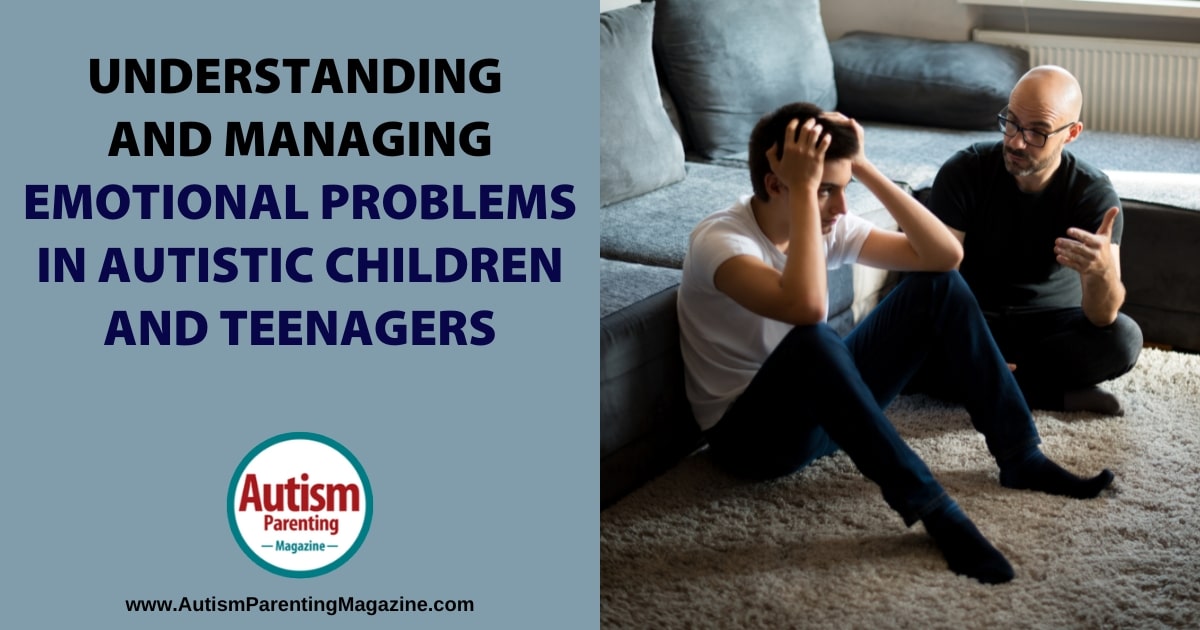Helping our children manage emotions requires understanding.
The teacher’s voice broke as she relayed the events of the day that culminated in her having to evacuate the class away from my son. In addition to yelling at people, he had also been throwing chairs. “It breaks my heart because this behavior has consequences that prevent others from knowing who he really is, and what he is capable of. He is the sweetest kid–when he is sweet.”
Emotional problems in autism can threaten our ability to see the whole person. How can we help our neurodivergent children with managing emotions, so that they can keep themselves and others safe, and show their amazing selves to the world?
For this article I want to broaden our view on emotional development, emotion regulation skills, and how we can help our children with autism spectrum disorder cope in a general population that too often just doesn’t “get it”.
How does autism factor into emotional problems?
“Autism Spectrum Disorder (ASD) is a neurodevelopmental disorder that is clinically defined by abnormalities in reciprocal social and communicative behaviors and an inflexible adherence to routinised patterns of thought and behavior. Laboratory studies repeatedly demonstrate that autistic individuals experience difficulties in recognizing and understanding the emotional expressions of others and naturalistic observations show that they use such expressions infrequently and inappropriately to regulate social exchanges. Dominant theories attribute this facet of the ASD phenotype to abnormalities in a social brain network that mediates social-motivational and social-cognitive processes such as face processing, mental state understanding, and empathy.”
This excerpt from a study called, The Interplay between Emotion and Cognition in Autism Spectrum Disorder: Implications for Developmental Theory, explains some of the problems children with ASD may face emotionally, that differ from their typically developing peers.
Rigid thinking
Rigid thinking can cause so much frustration for a person with autism and their families. When their need for schedules, timelines, and concrete concepts are met with changes in routine, quick transitions, and abstract ideas, it can result in rage, aggression, and meltdowns. These meltdowns are usually fueled by:
- fear
- anxiety
- lack of understanding
- lack of communication
- all of the above
Safety
What is safe and what isn’t can be a pretty cut and dried thing. Don’t go in the water if you can swim, don’t jump off buildings, don’t cross the street without looking etc.
However, what feels safe can vary widely from person to person. Loud noises, new places, new people, and new experiences may feel unsafe even if they are not harmful from a parent’s point of view.
Being misunderstood is one of the most reported hardships of people with autism spectrum disorders. Fear and anxiety are difficult enough, when they are dismissed, ignored, or downplayed it can cause major emotional problems.If we are not careful as parents, we can project our fear onto our children, or dismiss their fear if we don’t share it.
Children with autism who are prone to meltdowns, tantrums, violence, aggression, or rage often engage in these behaviors as a result of a fight response. They do not feel safe, and therefore, lash out. Since they are experiencing fear, they may lack the ability to respond appropriately to a situation.
Limited exposure
Only wanting to go certain places, talk about certain things, or participate in certain activities can limit a person’s exposure to new and exciting ways to connect with the world. Isolation can cause depression, anxiety disorders, and overall restrict the ability to learn and grow in the social and emotional skills needed.
Social and emotional skills
In an article titled: Understanding Social-Emotional Reciprocity in Autism: Viewpoints Shared by Teachers, we learn that, “Social-emotional reciprocity (SER) refers to an individual’s ability to engage in social interactions between two or more people.”
We also learn, “…individuals on the autism spectrum experience difficulties associated with an “inadequate appreciation of social-emotional cues, as shown by a lack of responses to other people’s emotions… poor use of social signals and a weak integration of social, emotional, and communicative behaviors” (World Health Organisation [WHO], 1990, p. 198).”
Social interaction can be difficult for autistic people. Their emotional responses, the way they express emotion, especially negative emotion, and the frustration they feel may lead to emotional dysregulation and subsequent behaviors.
Facial expressions
In a study called, The perception and identification of facial emotions in individuals with Autism Spectrum Disorders using the Let’s Face It! Emotion Skills Battery, we learn how it is difficult for some people with autism to accurately read other people’s facial expressions. This can make it confusing to understand a person’s meaning, as well as understand how their facial expressions match their words.
My son has this problem. At 19, wehe haved had many discussions about how he needsed me to be more intentional with my words and expressions. Sometimes I look angry, but sound happy to him. On other occasions I look fine, but sound angry.
This makes it more difficult for him to tell exactly what I mean, if I am annoyed with him, or if he needs to take action. Our relationship has grown after having conversations like this.
Body language
Just like facial expressions, it can be hard for autistic children, teens, and adults to read body language. Their own can also be a mystery to others. These misunderstandings can cause issues in communication and lead to emotional upset.
Puberty
As children with ASD grow into their pre-teen and teen years, puberty can bring new and worsening problems emotionally. For the general population and autistic children, puberty is a tricky time.
Social and emotional issues intensify, and the challenges autism can bring only compound this natural time of life. Extra support is needed before, during, and after those pubescent years.
Comorbid psychiatric disorders
Mental disorders are often seen with autism. Even though they are not autism, and don’t cause autism, they can often accompany it. Disorders such as:
- bipolar disorder
- anxiety disorders
- depression disorders
- schizophrenia
- other developmental disorders
Left untreated, emotional struggles can put your loved one at risk for self harm or even suicide. It is imperative to help our children with ASD with their mental health and emotional wellbeing as soon as possible.
What can parents do to help their children with ASD manage their emotions?

Emotional understanding is the key for parents and children with ASD. The more we as parents understand autism, our children, and their triggers, the more successful we will be. The more our children with ASD understand themselves, the more confident and behaved they will be.
This is not to say that understanding is the only thing needed. There are things we can do as parents to help ourselves and our children manage emotions and behaviors.
Parents
It has been reported that parents of neurodivergent children with difficult to manage behaviors may have higher levels of stress. This stress can make it more difficult to deal with behaviors in healthy ways.
Combating this will require us to be aware of our own emotions, an understanding of our child, and a willingness to operate from a different perspective–our child’s. One of the most impactful things we can do as parents is be a safe, understanding, warm, and inviting place to land, rest, and reciprocate love.
I don’t know how many times I have heard or read parenting tips from experts in gentle parenting, child psychologists, and other parents and felt empowered only to have that feeling dashed when I realize that the implementation of the skills I learned is like beating my head up against a brick wall. Does that mean that those tips don’t apply to my child?
The reality is, they do apply to him, but as a neurodivergent child, he needs me to practice them for myself, and present them to him from a perspective that makes sense to him.
The first step is learning how to manage my own emotions. This is difficult as most of us were not taught how. I would encourage you to consider therapy, support groups, books, and a commitment to giving yourself grace as you learn new skills. Then, model those skills for your autistic children.
Future research is needed, but current autism research suggests that though parental stress can be reduced by helping children with emotion regulation, parents could benefit greatly from support for themselves regardless of where their children are with their behavior. There are options now for parents that were not available before.

Click here to find out more
Children with autism
For our children with autism, teens, or adult loved ones with emotional troubles to receive help, they need to learn a few key truths about emotions. Let’s discuss some of those now.
Labeling emotions

Since things like, emotional facial expressions, tone of voice, other people’s emotions can be difficult to identify for people with autism. Learning to identify and label emotions, and how they show up in the body inside and outside, can help people with autism understand themselves and others. They can feel more successful in relationships, understanding love and humor in ways they hadn’t before, emotional regulation, and communicating their feelings to others more effectively with appropriate emotional expression.
Evidence suggests that with your help and the help of a qualified medical professional help is available. This can be done through:
- adolescent psychiatry
- child psychiatry
- child psychology
- ABA therapy
- medication
- social stories
- coping strategies
- emotional support animals

“Results from the Let’s Face It! Emotion Skills Battery have practical implications for designing effective interventions to improve the emotion processing skills of children with ASD (Golan, Ashwin, Granader, McClintock, Day, Leggett, et al. 2010; Tanaka, Wolf, Klaiman, Koenig, Cockburn, Herlihy, L., et al., 2010). Our findings suggest that treatment programs should promote the generalization of emotion recognition across a variety of people and social settings.
“Instruction should cue the child to emotional information conveyed in the eyes and its perceptual integration with information in the whole face. Fostering expression recognition abilities in individuals with ASD should enhance skills in social reciprocity and build confidence and competency in everyday social interactions.”
Here we see that a plan to help people with ASD learn to recognize different body language aspects could help greatly. It can boost their ability to understand and communicate with others, and help them deepen their relationships. This can reduce stress, prevent emotional difficulties, and learn coping strategies for behavior management.
Sensory aids

Sensory aids such as swings, noise reducing/canceling headphones, and others can reduce anxiety, and sensory issues that can impact emotional health. A child who is super distracted by noises can become irritable and may lash out against their peers or family members. Reducing stress reduces behaviors caused by it.
Regulating the body helps regulate emotions. Movement, sound, textures, sound reduction, manipulating objects, and moving from one sensory thing to another all can play a part in regulating the body. Sensory aids can help by giving the person using them the ability to self regulate safely.
Safety first

Teach your child they can be their own safe space. Our job as parents is to help them keep themselves safe. We can help them be their own safe space by providing for their needs.
This is especially true for teens and young adults. As a child moves from babyhood and childhood into teen and young adulthood, they learn to access and utilize the tools they have been provided more independently.
Resources
Here are some things that have been helpful to me and my family with dealing with emotions.
Teen Counseling through Betterhelp
On the Hard Days podcast, and @on.the.hard.days instagram. These have been a place of understanding and encouragement to me when dealing with my son’s emotional hurdles.
Summary
We all have days where we are emotional wrecks. I hope this article has helped to bring understanding, encouragement, and empowered you.
References
Gaigg S. B. (2012). The Interplay between Emotion and Cognition in Autism Spectrum Disorder: Implications for Developmental Theory. Frontiers in integrative neuroscience, 6, 113. https://doi.org/10.3389/fnint.2012.00113
Schwartz, L., Beamish, W., & McKay, L. (2021). Understanding Social-Emotional Reciprocity in Autism: Viewpoints Shared by Teachers. Australian Journal of Teacher Education, 46(1). http://dx.doi.org/10.14221/ajte.202v46n1.2
Tanaka, J. W., Wolf, J. M., Klaiman, C., Koenig, K., Cockburn, J., Herlihy, L., Brown, C., Stahl, S. S., South, M., McPartland, J. C., Kaiser, M. D., & Schultz, R. T. (2012). The perception and identification of facial emotions in individuals with autism spectrum disorders using the Let’s Face It! Emotion Skills Battery. Journal of child psychology and psychiatry, and allied disciplines, 53(12), 1259–1267. fichas direcionadas
Tarver, J. H., Palmer, M. L., Webb, S., Scott, S. B. C., Slonims, V., Simonoff, E., & Charman, T. (2019). Child and parent outcomes following parent interventions for child emotional and behavioral problems in autism spectrum disorders: A Systematic Review and Meta-Analysis. Autism, 23(7), 1630-1644. https://doi.org/10.1177/1362361319830042
[ad_2]
Autismo news




